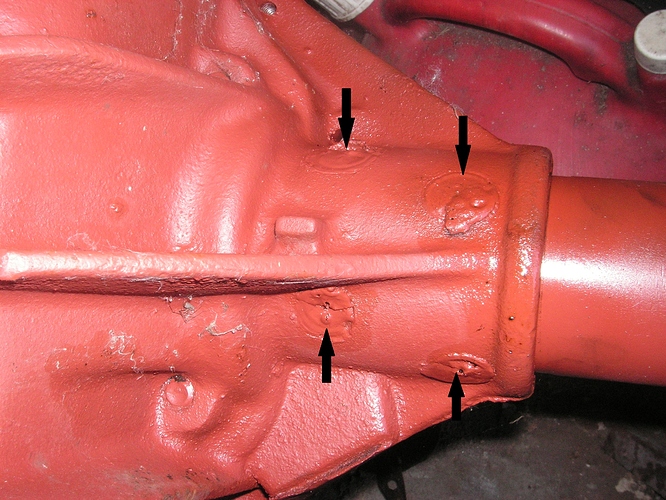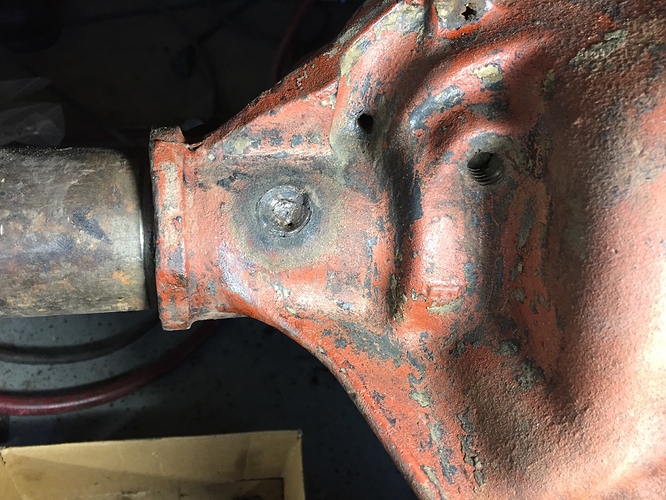During an inspection of my back axle (XK150 Salisbury LSD) the opportunity was taken to replace the wheel bearings. They were VERY tight and requires a lot of heat and some heavy duty Lump hammer therapy - on both sides. Eventually the bearing/half shafts came free. After the process witness marks indicated that the axle casing had moved outwards from the diff. casing by an even 1/8 inch on both sides. My friend Jesse who was doing the heavy work noted that in his long experience he had never seen such a recalcitrant bearing before or noticed the movement of the axle tube. Has anyone else come across this?
I propose to see how the alignment is with the springs and if necessary use a couple of long clamps to press the tubes back in. Again and as always any sage advice appreciated
Mike Gladwin
1960 XK150 FHC
1962 A/H 3000
I would be concerned about the bearing alignment between the hubs and the differential carrier.
I would suspect that this problem might get worse with use. It sounds like the plug welds between the tubes and diff case have given way and will need drilling out and rewelding once the alignment has been checked. I have heard about this problem, but not actually seen it happen. It really needs fixing before irreprable damage is done.
I have just rebuilt my mk9 axle and also had severe problems bashing out the bearing races, fortunatly my case is still ok.
Yikes. In addition to the friction fit, the axle tubes are spot brazed to the center carrier. I have no idea how you would break that bond removing the bearing race and axle, and I’ve done a bunch of them, but apparently, that ship has nonetheless sailed. I would think you could draw them back into place with a long piece of heavy threaded rod and a couple of matching nuts. Feed the rod through both tubes and center section, slide a heavy plate with a hole only slightly larger than the rod over each end, then wind the nuts down to pull the tubes together. In the USA I would use a piece of threaded rod at least 3/4"in diameter. It is readily obtainable in long lengths at construction supply houses. It is commonly used to trapeze heavy piping and electrical conduit in industrial and heavy commercial buildings.
The tubes on my mk9 axle are welded in rather than brazed. The welding slag is still present. I would agree with the above post. I wouldn’t just press them back in and hope for the best they need re welding.
Are you in USA or UK?
I am currently rebuilding my mk9 axle and have made all the necessary tools. ie. Spreader, pinion extractor, bearing puller, preload tester etc.
I’m in the US in Washington DC. I will refit the axle for now as I need to roll the car on to a trainer to go to the body shop. What interests me is that the tubes have moved out by exactly the same distance on both sides. There also seems to be some fretting (or rust pitting) on the witness face. Both sides needed similar amounts of heat and bashing to release the bearing so were subject to the same loads,. I will take a look to see if mine were brazed or welded.
Thanks for your help
Mike
-
Interesting way of attachment. I wonder why they did not arc-weld the axle-tubes to the diff. housing, in the same way the outer bearing carrier is attached to the axle-tube.
-
I have a number of long pipe clams that I may try to squeeze the tubes back in. I’ll check the line up on the spring alignment bolts first.
-
Interesting that both sides moved by the same amount.
Thanks for your help
Mike
I count a total of four plug welds on each axle tube, total eight.
It seems really unlikely that they could all fail.
Are you sure the tubes have really moved?
When these axles were made, the clean dry shot blasted raw diff casting was dipped in orange sealer before any machine cutting of the smooth surfaces. That orange stuff stuck really well. Then all the machining was done with lots of cutting oil all over it. After it was machined, the axle tubes were pushed in, probably with some grease on the end to get them to slide in easier. Then they were plug welded in place. The welding burned off the oil but only in the area of the welds. Then all the gear assembly work was done.
We have noticed before that they were probably not cleaned all that well before the final coat all over of black paint, probably still greasy and oily especially on the diff, such that the black often flakes off the diff casting, and people erroneously think it should be restored orange.
I noticed that with the axle in my picture. The black paint on the diff had stuck well only on the plug welds, but was flaking off almost everywhere else on the diff. But the original black paint had stuck pretty well to the axle tubes, except about 1/4" from where they entered the diff casting. Pity it never occurred to me to take a picture of it before I put primer on it.
Perhaps you cleaned the axle and are seeing where the black paint stuck well to the tube and yet failed to stick well in the area that was greasy from pushing the tube in, making it look like the tube came out.
Is there someone with a bare XK axle who will measure the overall
between the flanges? If not try a axle specialist.
Peter
I have four per side on mine similar to yours and they appear to be ugly arc welds, possibly pins which are then welded in place. The orange sealer seems an equivalent to Gyptol a product developed by GE to seal-in pockets of hidden casting-sand in large oil filled castings and motor housings. My pictures tend to confirm your contention that the pins are welded after painting as you can see by the burn marks. You can just see from the lower picture the witness mark of the axial movement. I was incorrect when I said it was even movement on both sides: it was 0.2 inch on the RHS and 0.06 on the LHS.
It could be that the tubes fractured outboard of the plug welds: I would get/beg/borrow a borescope to find out.
Good idea and an excuse to buy more equipment!
I usually dont need much coaxing in that department!!!
Mike’s pictures show several differences to Rob’s. 1 weld point in each photo versus 4, different case webbing, …
Witness mark not too clear but seems to indicate recent axial motion of tube relative to case. Perhaps large forces applied somewhere by a hammer transferred to tube, broke welds, moved tube outwards? With only one or two welds per side, big hammer forces could wreck some havoc on welds away from hammer impact points. Is the witness mark fresh or the result of some motion occurring over time during driving? Was the witness mark present before repairs began?
Perhaps also measure up the two sides and compare with known good rear assembly. I would be reluctant to ride in a car with that joint loose.
Yes, Glyptal is a sealer that prevents the microscopic sand particles from migrating out of the boundary layer of the raw casting and getting where you don’t want them, i.e. in the bearings. On machined surfaces the boundary layer has been machined off so you don’t need to restore the Glyptal again.
I think it unlikely that they would use pins; more likely they bored 3/4" diameter holes through to the main bore. The tubes were pressed in, then they filled up those holes with weld.
What you call a witness mark is actually the machine cut end of the tube, which was done in a lathe on something like the last 4 inches to make it fit tightly in the casting. Because the castings are not faced off on that stub and are not all exactly the same size, the machining on the tube was done a little bit longer than the depth of the bored hole in the casting, so they could be sure of seating the tube in the bottom of the bore. You can see it a little better in my picture; if you look carefully there is a slight change in the diameter about 1/8" from the casting and the surface is smoother. There is a step at the bottom of this bored hole, which possibly could be seen from the inside if the crown gear was removed. The rest of the tube is not machined on the outside, it is as produced in the steel factory. Without being able to see the inside, I am guessing it is made by a process called Drawn Over Mandrel or DOM, sometimes called Smooth Bore Seamless.
You could look for evidence of movement at the spreader holes on the back side.
That is the tubes you are seeing in those holes.

You could also take out the crown gear carrier and see the tube ends, see if the tubes have moved. My feeling is they have not.
Mike,
This is how my XK120 axle looked in 3 stages:
Before
First dirt scraped off:
Washed:
Note the machine marks on the axle tubes and black paint visible in places when the dirt has been initially clened.
Rob, the last photo also confirms that the red paint was applied prior to welding the tubes.
Tadek
Rob Reily is spot on with his comments. I have just looked at my axle and can clearly see that a portion of the tubes have been machined to size, prior to fitting to the differential case. This leaves about 1/4 inch of machined tube showing either side of the case. If I look into the spreader holes I can even see the turning marks.
So, I don’t think you have a problem.
I think that the factory assembly procedure would be to machine the tubes, heat the casing, press the tubes in and plug weld. Heating the casing would expand the case and also pre heat for welding. When it cooled the tubes would be a shrink fit as well as welded.
Can someone tell me how to put photos on this site as I have taken some?
I suggested brazed rather than welded because it is generally not possible to weld cast iron, and so far as I know, while the tubes are clearly steel, I believe that the center section is a casting, not a forging (iron vs steel).
Cast can be welded, but, the entire casting has to heated up, and a high nickel rod used.
Great ideas and conversation. I took a file to the filler and confirm that it is weld. It may be that the alleged witness marks are machine marks. When I get back to the garage (after ‘sacrificial turkey day’) I will:
- check the marks with a magnifying glass
- check for witness marks in the spreader holes - - this should be be definitive.
- measure from the flange of the diff housing to the outer flange on both sides.
Have a happy Thanksgiving holiday all you Yankees.
Mike
Yes sir, I am very familiar with the process, but it is very rarely done and I have never seen it suggested that was the process used to join the axle tubes to the center section, or any other mass produced item, for that matter. You generally have to have a really good reason to need to weld cast iron, usually because the part is not easily replaceable or quite expensive.


